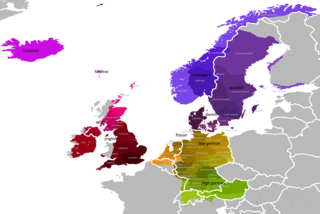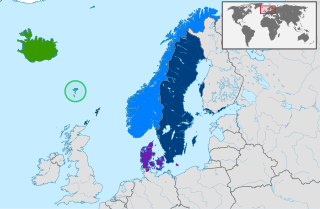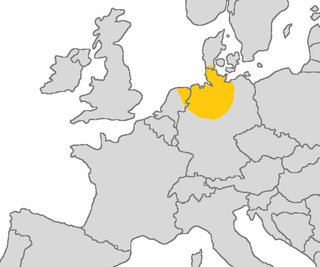
In phonology, an allophone is one of multiple possible spoken sounds – or phones – used to pronounce a single phoneme in a particular language. For example, in English, the voiceless plosive and the aspirated form are allophones for the phoneme, while these two are considered to be different phonemes in some languages such as Central Thai. Similarly, in Spanish, and are allophones for the phoneme, while these two are considered to be different phonemes in English.

The Germanic languages are a branch of the Indo-European language family spoken natively by a population of about 515 million people mainly in Europe, North America, Oceania and Southern Africa. The most widely spoken Germanic language, English, is also the world's most widely spoken language with an estimated 2 billion speakers. All Germanic languages are derived from Proto-Germanic, spoken in Iron Age Scandinavia and Germany.

Old Norse, Old Nordic, or Old Scandinavian is a stage of development of North Germanic dialects before their final divergence into separate Nordic languages. Old Norse was spoken by inhabitants of Scandinavia and their overseas settlements and chronologically coincides with the Viking Age, the Christianization of Scandinavia and the consolidation of Scandinavian kingdoms from about the 8th to the 15th centuries.

The North Germanic languages make up one of the three branches of the Germanic languages—a sub-family of the Indo-European languages—along with the West Germanic languages and the extinct East Germanic languages. The language group is also referred to as the Nordic languages, a direct translation of the most common term used among Danish, Faroese, Icelandic, Norwegian, and Swedish scholars and people.

Proto-Germanic is the reconstructed proto-language of the Germanic branch of the Indo-European languages.
The orthography of the Old Norse language was diverse, being written in both Runic and Latin alphabets, with many spelling conventions, variant letterforms, and unique letters and signs. In modern times, scholars established a standardized spelling for the language. When Old Norse names are used in texts in other languages, modifications to this spelling are often made. In particular, the names of Old Norse mythological figures often have several different spellings.
Middle Dutch is a collective name for a number of closely related West Germanic dialects whose ancestor was Old Dutch. It was spoken and written between 1150 and 1500. Until the advent of Modern Dutch after 1500 or c. 1550, there was no overarching standard language, but all dialects were mutually intelligible. During that period, a rich Medieval Dutch literature developed, which had not yet existed during Old Dutch. The various literary works of the time are often very readable for speakers of Modern Dutch since Dutch is a rather conservative language.

Old Saxon, also known as Old Low German, was a Germanic language and the earliest recorded form of Low German. It is a West Germanic language, closely related to the Anglo-Frisian languages. It is documented from the 8th century until the 12th century, when it gradually evolved into Middle Low German. It was spoken throughout modern northwestern Germany, primarily in the coastal regions and in the eastern Netherlands by Saxons, a Germanic tribe that inhabited the region of Saxony. It partially shares Anglo-Frisian's Ingvaeonic nasal spirant law which sets it apart from Low Franconian and Irminonic languages, such as Dutch, Luxembourgish and German.
Swedish has a large vowel inventory, with nine vowels distinguished in quality and to some degree in quantity, making 18 vowel phonemes in most dialects. Another notable feature is the pitch accent, a development which it shares with Norwegian. Swedish pronunciation of most consonants is similar to that of other Germanic languages.
The sound system of Norwegian resembles that of Swedish. There is considerable variation among the dialects, and all pronunciations are considered by official policy to be equally correct – there is no official spoken standard, although it can be said that Eastern Norwegian Bokmål speech has an unofficial spoken standard, called Urban East Norwegian or Standard East Norwegian, loosely based on the speech of the literate classes of the Oslo area. This variant is the most common one taught to foreign students.
A-mutation is a metaphonic process supposed to have taken place in late Proto-Germanic.
Old English phonology is necessarily somewhat speculative since Old English is preserved only as a written language. Nevertheless, there is a very large corpus of the language, and the orthography apparently indicates phonological alternations quite faithfully, so it is not difficult to draw certain conclusions about the nature of Old English phonology.
Like many other languages, English has wide variation in pronunciation, both historically and from dialect to dialect. In general, however, the regional dialects of English share a largely similar phonological system. Among other things, most dialects have vowel reduction in unstressed syllables and a complex set of phonological features that distinguish fortis and lenis consonants.
There is significant phonological variation among the various Yiddish dialects. The description that follows is of a modern Standard Yiddish that was devised during the early 20th century and is frequently encountered in pedagogical contexts.

Gothic is an extinct East Germanic language that was spoken by the Goths. It is known primarily from the Codex Argenteus, a 6th-century copy of a 4th-century Bible translation, and is the only East Germanic language with a sizeable text corpus. All others, including Burgundian and Vandalic, are known, if at all, only from proper names that survived in historical accounts, and from loanwords in other, mainly Romance, languages.
The following list is a comparison of basic Proto-Slavic vocabulary and the corresponding reflexes in the modern languages, for assistance in understanding the discussion in Proto-Slavic and History of the Slavic languages. The word list is based on the Swadesh word list, developed by the linguist Morris Swadesh, a tool to study the evolution of languages via comparison, containing a set of 207 basic words which can be found in every language and are rarely borrowed. However, the words given as the modern versions are not necessarily the normal words with the given meaning in the various modern languages, but the words directly descended from the corresponding Proto-Slavic word. The list here is given both in the orthography of each language, with accent marks added as necessary to aid in pronunciation and Proto-Slavic reconstruction. See below for a capsule summary of how to pronounce each language, as well as some discussion of the conventions used.
Old Norse has three categories of verbs and two categories of nouns. Conjugation and declension are carried out by a mix of inflection and two nonconcatenative morphological processes: umlaut, a backness-based alteration to the root vowel; and ablaut, a replacement of the root vowel, in verbs.
Proto-Sámi is the hypothetical, reconstructed common ancestor of the Sámi languages. It is a descendant of the Proto-Uralic language.
The phonology of Old Saxon mirrors that of the other ancient Germanic languages, and also, to a lesser extent, that of modern West Germanic languages such as English, Dutch, Frisian, German, and Low German.
The phonological system of the Old English language underwent many changes during the period of its existence. These included a number of vowel shifts, and the palatalisation of velar consonants in many positions.








